![]()
This projects page contains some software projects, some
were written in compiled BASIC others in C. Others without an in depth
description appear in a Software Portfolio listing.
The source code is available via FTP at ftp://ftp.frontiernet.net/pub/users/erickclasen/public_ftp/C/ and ftp://ftp.frontiernet.net/pub/users/erickclasen/public_ftp/BAS/
respectively for C files or BASIC files. Most of them are simple command line utilities, however a
few are quite complex. The BASIC programs I compile with the Power Basic
compiler. The C programs are compiled with Borland 3.0 or GCC depending
on the target.
First a bit of history
When I started with computers in 6th grade it was with a TRS-80
pocket computer (Clock speed 540 kHz, ~1K RAM), the first version that
they sold. This was followed quickly by a VIC-20 (6502@2mHz, 3K RAM).
As I got used to BASIC, I started writing more and more complicated
programs. Some favorite non-graphical games were a stock market game
based on random prices attached to letter sequences that were
generated. From the initial price, small random deltas were introduced
to the prices. The object of the game was to watch the "ticker tape"
ASCII go by on the screen and buy and sell the stocks, making a profit.
This was sort of a day trading game, simple but entertaining.
Another was a non-graphical flight simulator that was based on some basic physics, using numerical methods.
On the screen you would see the instruments represented in numbers and would fly based on these instruments.
A lot of work was put into this one and it worked fairly good for what it was.
The next big step was graphics, most programs written with graphics
were a hybrid, BASIC for the main program with machine language calls
for the graphics routines. One of the initial hurdles was the fact that
there was no assembler available at the time for the VIC-20. I wrote a
few short segments of machine language by poking in the op-codes using
the 6502 book, this got old fast. But it did prove the merits of
machine code. The speed difference was amazing. Filling the screen
entirely with one repeated character would take a noticeable amount of
time in BASIC. Using machine code, it would appear to instantly flash
the entire screen at once. I was hooked.
I then wrote an assembler/machine language monitor tool in BASIC using
the 6502 book as a guide. This enabled me to write in assembly and
load the machine code into memory. This worked better, still slow going
to write software. But the payoff was that the machine language could
write to the screen at a much higher rate that the interpreted BASIC.
The easiest way to load the assembly was to treat it
as data and allow the BASIC program to load it into RAM on start up.
This made it possible to write games that had a lot of graphics refresh such as Pacman and grotto style games.
Besides writing game software I wrote some software that would model
physics such as simulations of launching artillery and
missiles. One other thing I used frequently and toyed with was
numerical methods. I was basically doing calculus type math on
the computer, years before I knew what it was. One of my favorites at
that time was algorithms along the lines of Newton's method. Newton's
method is typically used to find a square root by successive
approximations. I used it and an algorithm that closes in on a target
value using
a Tractrix curve in a lot of places. These were used as control
algorithms behind the flight simulator and controlling the ghosts on
the Pacman
game.
That sums up how I started with programming.
Data Encryption of Files Using Random Files as Keys
The following shows an example of encrypting the word hello.
Add Method
Input File Key File Output File
Letter ASCII ASCII
value value value
h 104 63 203
e 101 87 188
l 108 135 243
l 108 68 176
o 111 222 77 (111+222 = 333 with '8 bit rollover' 333-256 = 77)
To decode the output file requires the key file and works by subtraction.
Subtract Decryption
Input File Key File Output File
ASCII ASCII ASCII Letter
value value value
203 63 104 h
188 87 101 e
243 135 108 l
176 68 108 l
77 222 111 o (77-222 = -145 with '8 bit rollover' -145+256 = 111 )
The encode operation would appear as follows.
XOR Method
Input File Key File Output File
Letter ASCII ASCII ASCII
value value value
h 104 63 87
e 101 87 50
l 108 135 235
l 108 68 40
o 111 222 177
To decode the output file requires the key file and works by subtraction.
XOR Decryption
Input File Key File Output File
ASCII ASCII ASCII Letter
value value value
87 63 104 h
50 87 101 e
235 135 108 l
40 68 108 l
177 222 111 o (77-222 = -145 with '8 bit rollover' -145+256 = 111 )
Lunar Phase Program
The almanac and calender information presented on the Almanac with Sun and Moon Position and Lunar Events pages was generated by a software algorithm. It is quite accurate, so far it seems to line up well with the reality in the sky.
For the lunar months, the numbering was considered to start with the first new moon of the new calender year, this is somewhat arbitrary and there might be some better suggestions.
The time base for the calculations is UTC. Items calculated for a given day are calculated at 00:00 UTC for that day. The moon Zodiac gives the moons position exactly when it is in a given sign. The sun Zodiac follows the traditional, divide the year up into 12 equal parts method.
Glossary of abbreviations
AGE = Moons age in days since it became new.
D(AU) = The suns distance from the earth, in Astronomical Units.
D(ER) = The moons distance in Earth radii.
Exct Zodiac = Zodiac that the moon is in, exactly, no rounding to a 30 degree window.
LAT = The moons latitude along the ecliptic, in degrees.
LONG or Mn LONG = The moons longitude along the ecliptic, in degrees.
MM/DD/YYYY:HH:MM = Format in date and 24 Hour time UTC.
Sun Age = The number of days since the last spring equinox.
Sun LAT = The Suns latitude along the ecliptic, in degrees.
Sun LONG= The approximate position of the Sun in degrees latitude with reference to the earths equator.
The software was built in C some of the parts of the code namely
the algorithms for the moon and sun position were available on-line
from
observatories. SAAO- NAO Technical Note No. 46(1978) and Moonlight
Cascade Observatory/BBS. Around the algorithms an interface was built
that drives the
program from the command line. I consider the data to be accurate, but
there are no guarantees as with any software.
Code was then created to format the output. Tables in the code was
created, for example one to interpret the Zodiac sign correctly,
deriving the zodiac given the ecliptic longitude.
Internal to the program the date that is input by the user is
converted to Julian date. The program is aware of the switch over from
Julian to Gregorian calender and accommodates this as well. The
Gregorian calender fix is to, force a date in the range 10/4 -
10/14/1582 to 10/15/1582.
This forces the values in range, being that the calender omitted
9 days when switching from Julian to Gregorian. A table exists in the
code to
interpret where we are in the season, early,late and the midpoint by
determining the approximate midpoints of each season. The day of the
week is selected
using a look-up table function, the input to this table is a modulo 7
operation on the Julian date. Monday 12/3/2007 for example is JD
2454438. Doing the
operation 2454438 % 7 yields 0. An input of zero to the look-up table
references the string "Monday" from which the screen output is
generate. This is
similar to the operations for picking the Zodiac string as well as the
part of the Season, lunar phase. However these are provided by dividing
the month
into subsets of time for the lunar phase and dividing the angle of the
sun along the ecliptic (longitude) into the specific 30 degree sections
that
resolve into the 12 Zodiac symbols.
For the lunar Zodiac a table was found on-line that resolves the lunar
position to the exact Zodiac. The premise here is that the Zodiac
regions in the
sky do not all take up 30 degrees, some are wider and some are
narrower. So a look-up table was constructed based on this fact to
resolved the lunar Zodiac more precisely. Remember the fact that the
Moon traverses the entire Zodiac in 27.321582241 days, this is its
complete course of 360 degrees of ecliptic longitude. The moon goes
through its phases every 29.530588853 days so this is divided into the
various phases in a look-up table within the
program. There are also similar relationships for the ecliptic latitude
for the moon and distance from the earth to the moon.
While the moon on average rides along the ecliptic plane it oscillates
above and below it plus or minus approximately 5.1 degrees. The period
of this oscillation is 27.212220817 days. There are times when the moon
will ride 'high' in the sky during the month and then ride 'low' at the
opposite time
of the month (more closer to 2 weeks for half cycles, a fortnight). The
moons distance varies with a sort of ellipse relationship with a period
of
27.55454988 days, this as well is handled by the program and is given
in terms of earth radii.
In this process phase based on the age of the room is converted to
degrees and the finally radians to carry out the actual math. From this
the results are displayed in degrees latitude/longitude, earth radii as
appropriate or fed into the Zodiac look-up table function. For the Sun
very similar calculations are carried out, so you can extrapolate in
your mind what was done for the moon is similarly done for the sun
calculations.
The following is a printout of the help menu generated when the program is runs using the /? option
Lunar phase and position & Solar position calculator DOS Version:00.9
NOTE 1) Solar latitude is approximate. 2) Lunar Zodiac is exact.
Enter lphase /t at the command line to compute data for
the moon on todays date.
Enter lphase /c to produce a perpetual calender view using
a starting date and a number of days to span out.
Enter lphase /h to produce a detailed output of lunar data
for one day on a 0.5 hour basis.
Enter lphase /e at the command line to produce 1 yr calender
data for up to the minute full/new moon & eclipses.
Otherwise run the program and enter the date
in MM/DD/YYYY format.
Lunar phase and position & Solar position calculator DOS Version:00.9
NOTE 1) Solar latitude is approximate. 2) Lunar Zodiac is exact.
Input date in this format MM/DD/YYYY
Target Date: 12/1/2007
Julian Date = 2454436 day = Saturday
Moon Data
----------------------
phase = Last quarter
age = 21.432411 days
distance = 61.464302 earth radii
ecliptic
latitude = 0.105118
longitude = 158.001190
constellation = Leo
Sun Data
----------------------
season = Late Autumn
age = 254.994125 (days since spring equinox)
distance = 0.953412 AU
aprx. latitude= -21.9 (with ref. to the equator)
ecliptic
longitude = 248.908997 alt calc = 248.403625
constellation = Sagittarius
For the tabular output, potential eclipses are marked off as well. The algorithm searches the entire year on a minute by minute basis for when the moon crosses the ecliptic plane and marks these events off. It also marks off the points where the moon is exactly full or new. This mode is invoked by calling the program with the /e option.
New and Full Moons Date and Time and eclipses.
MM/DD/YYYY:HH:MM Day Phase Age Dist(ER) LAT LONG Mn Zodiac Solar LONG
01/07/2008:15:05 Monday *NEW 0.000225 56.002979 -3.502999 286.661469 Sagittarius286.556732
01/22/2008:09:28 Tuesday *FULL 14.765902 56.128639 2.397222 122.302750 Cancer 301.835297
02/06/2008:03:49 Wednesday *NEW 0.000225 56.400490 -1.122187 317.778534 Aquarius 317.070587
*02/20/2008:22:12 Wednesday *FULL 14.765902 59.869110 -0.234372 155.133789 Leo 331.224060
03/06/2008:16:33 Thursday *NEW 0.000000 60.642876 1.572592 349.585266 Pisces 346.294556
03/21/2008:10:56 Friday *FULL 14.765676 61.454948 -2.800189 183.824554 Virgo 1.248665
04/05/2008:05:17 Saturday *NEW 0.000000 62.133255 3.827228 17.884167 Pisces 16.077461
04/19/2008:23:40 Saturday *FULL 14.765676 63.759281 -4.582811 207.623703 Virgo 29.803162
05/04/2008:18:01 Sunday *NEW 0.000000 63.571266 5.011314 41.203468 Aries 44.394379
05/19/2008:12:24 Monday *FULL 14.765676 63.198814 -5.083253 234.785599 Libra 58.879509
06/03/2008:06:45 Tuesday *NEW 0.000000 62.720821 4.793333 68.543419 Taurus 73.279495
06/18/2008:01:08 Wednesday *FULL 14.765676 62.070129 -4.161643 262.403992 Scorpio 87.619057
07/02/2008:19:29 Wednesday *NEW 0.000000 58.041470 3.234461 96.705940 Gemini 100.972939
07/17/2008:13:52 Thursday *FULL 14.765676 57.342579 -2.075667 291.889771 Sagittarius115.276794
*08/01/2008:08:13 Friday *NEW 0.000000 56.809528 0.770566 127.160133 Cancer 129.606400
*08/16/2008:02:36 Saturday *FULL 14.765676 56.367432 0.590797 322.654419 Aquarius 143.990601
08/30/2008:20:57 Saturday *NEW 0.000000 56.793522 -1.908690 162.338470 Leo 157.486954
09/14/2008:15:20 Sunday *FULL 14.765676 57.378357 3.092191 357.692719 Pisces 172.044525
09/29/2008:09:42 Monday *NEW 0.000676 58.050694 -4.054620 192.834625 Virgo 186.719177
10/14/2008:04:04 Tuesday *FULL 14.765450 58.803432 4.728450 27.781933 Pisces 201.519135
10/28/2008:22:26 Tuesday *NEW 0.000451 62.728092 -5.065466 220.980331 Virgo 215.445679
11/12/2008:16:48 Wednesday *FULL 14.765450 63.223751 5.041820 54.704449 Taurus 230.483215
11/27/2008:11:10 Thursday *NEW 0.000451 63.574810 -4.659095 248.317261 Scorpio 245.624420
12/12/2008:05:32 Friday *FULL 14.765450 63.765827 3.944679 81.857407 Taurus 260.845642
12/26/2008:23:54 Friday *NEW 0.000451 62.124603 -2.949401 271.641693 Sagittarius275.097992
In the above tabular chart the dates preceded by an asterisk are potential eclipse dates. If the moon phase is listed as FULL for that date the eclipse will be a lunar eclipse. If the moon phase is listed as NEW for that day it will be a solar eclipse.
Finally below is the tabular almanac output. This mode is invoked by calling the program with the /c option. The page on this siteAlmanac has an extended printout of this output.
MM/DD/YYYY Day Phase AGE D(ER) LAT LONG Exct Zodiac Sun Age D(AU) Sun LAT Sun LONG
12/01/2007 Saturday Last quarter 21.432 61.46 0.11 158.00 Leo 254.99 0.953 -21.9 248.91
---- Sagittarius Late Autumn -----
12/02/2007 Sunday *Last quarter 22.432 62.28 -1.06 170.45 Leo 255.99 0.953 -22.1 249.92
12/03/2007 Monday Last quarter 23.432 62.93 -2.18 182.58 Virgo 256.99 0.953 -22.2 250.94
12/04/2007 Tuesday Waning crescent 24.432 63.40 -3.18 194.49 Virgo 257.99 0.953 -22.3 251.95
12/05/2007 Wednesday Waning crescent 25.432 63.68 -4.00 206.26 Virgo 258.99 0.953 -22.5 252.97
12/06/2007 Thursday Waning crescent 26.432 63.77 -4.62 217.99 Virgo 259.99 0.953 -22.6 253.98
12/07/2007 Friday Waning crescent 27.432 63.71 -4.99 229.74 Libra 260.99 0.953 -22.7 255.00
12/08/2007 Saturday NEW 28.432 63.53 -5.10 241.58 Libra 261.99 0.952 -22.8 256.01
12/09/2007 Sunday NEW 29.432 63.24 -4.93 253.53 Scorpio 262.99 0.952 -22.9 257.03
------------------ Lunar Month 1 ------------------
12/10/2007 Monday NEW 0.902 62.88 -4.51 265.63 Scorpio 263.99 0.952 -23.0 258.04
12/11/2007 Tuesday Waxing crescent 1.902 62.45 -3.84 277.89 Sagittarius 264.99 0.952 -23.1 259.06
12/12/2007 Wednesday Waxing crescent 2.902 61.97 -2.97 290.32 Sagittarius 265.99 0.952 -23.1 260.08
12/13/2007 Thursday Waxing crescent 3.902 61.44 -1.95 302.94 Capricorn 266.99 0.952 -23.2 261.09
12/14/2007 Friday Waxing crescent 4.902 60.85 -0.82 315.78 Aquarius 267.99 0.952 -23.3 262.11
12/15/2007 Saturday First quarter 5.902 60.22 0.36 328.84 Aquarius 268.99 0.952 -23.3 263.13
12/16/2007 Sunday *First quarter 6.902 59.55 1.51 342.17 Aquarius 269.99 0.952 -23.4 264.14
12/17/2007 Monday First quarter 7.902 58.87 2.59 -4.21 Pisces 270.99 0.951 -23.4 265.16
12/18/2007 Tuesday First quarter 8.902 58.21 3.52 9.71 Pisces 271.99 0.951 -23.4 266.18
12/19/2007 Wednesday Waxing gibbous 9.902 57.62 4.27 23.92 Pisces 272.99 0.951 -23.5 267.20
12/20/2007 Thursday Waxing gibbous 10.902 57.14 4.80 38.40 Aries 273.99 0.951 -23.5 268.22
12/21/2007 Friday Waxing gibbous 11.902 56.82 5.07 53.08 Taurus 274.99 0.951 -23.5 269.23
12/22/2007 Saturday Waxing gibbous 12.902 56.71 5.07 67.89 Taurus 275.99 0.951 -23.5 270.25
---- Capricorn Winter Solstice -----
12/23/2007 Sunday FULL 13.902 56.84 4.80 82.71 Taurus 276.99 0.951 -23.5 271.27
12/24/2007 Monday *FULL 14.902 57.20 4.27 97.44 Gemini 277.99 0.951 -23.5 272.29
12/25/2007 Tuesday FULL 15.902 57.79 3.52 111.97 Gemini 278.99 0.951 -23.5 273.31
12/26/2007 Wednesday Waning gibbous 16.902 58.56 2.58 126.18 Cancer 279.99 0.951 -23.4 274.33
12/27/2007 Thursday Waning gibbous 17.902 59.45 1.51 139.99 Leo 280.99 0.951 -23.4 275.35
12/28/2007 Friday Waning gibbous 18.902 60.41 0.35 153.38 Leo 281.99 0.951 -23.4 276.36
12/29/2007 Saturday Waning gibbous 19.902 61.34 -0.82 166.31 Leo 282.99 0.951 -23.3 277.38
12/30/2007 Sunday Last quarter 20.902 62.18 -1.95 178.82 Virgo 283.99 0.951 -23.2 278.40
12/31/2007 Monday *Last quarter 21.902 62.87 -2.98 190.99 Virgo 284.99 0.951 -23.2 279.42
Wxstat program
The equation of time is the sum of two offset sine curves, with periods of one year and six months respectively. The equation of time is the difference, over the course of a year, between time as read from a sundial and a clock. It can be ahead by as much as 16 min 33 s (around November 3) or fall behind by as much as 14 min 6 s (around February 12). It results from an apparent irregular movement of the Sun caused by a combination of the obliquity of the Earths rotation axis and the eccentricity of its orbit. The equation of time is visually illustrated by an analemma. Apparent solar time (or true or real solar time) is the time indicated by the Sun on a sundial, while mean solar time is the average as indicated by clocks.
retVal = (sin(suns ecliptic longitude)+1)*(UPPER_LIMIT - LOWER_LIMIT)/2 + LOWER_LIMIT
UPPER_LIMIT = 15.25
LOWER_LIMIT = 9.1
Average daily temperature calculation. This calculation required some preliminary research into what the lowest and highest daily average temperatures and when they occur. It was determined by looking at data from the NCDC that for the Binghamton region that the temperature excursions lag the actual seasons by approximately 36 degrees. See the weather class page for more information on climates.The lowest average temperature for the winter season here will occur Jan 27, 2007. The maximum average summer temperature will occur July 27, 2007. Knowing these 2 points and looking up the average temperature on both is what is needed to generate a approximation for average temperature. It is basically a sine curve that is offset 36 days from the seasons so that its minima and maxima occur ,Jan 27 and July 27 respectively. The scaling function is similar to the function that generates the length of day.
temp = sin((age + SEAS_OFFSET) * DAY_RADIAN);
retVal = (temp+1)*(upperLim - lowerLim)/2 + lowerLim;
The following is a printout that the wxstat program outputs for an example.
DOS Version:00.1
NOTE 1
Input date in this format MM/DD/YYYY
Target Date: 12/1/2007
Julian Date = 2454436 day = Saturday
Sun Data
----------------------
season = Late Autumn
age = 254.994125 (days since spring equinox)
aprx. latitude= -21.9 (with ref. to the equator)
Apx.Day Len. 09:15 hrs
Apx.Rise: 07:14 EST Apx.Set: 16:28 EST
Equation of Time 11:40 min
Fudge Factor:0.018039
Mean moon rise: 00:-10
Weather Data
----------------------
Avg Low Temp 17 F Avg High Temp 35 F Mean Temp 26 F
Cmdcalc program
c:\cmdcalc 5*5
25
c:\
c:\cmdcalc M*5
125
c:\
The BASIC for this program is so simple that I have included the source as follows.
10 ver = 1.02:dim a$[10], a[10]:arg = 1
20 if command$ ="/?" then 5000
25 lencommand = len(command$)
26 open "c:\tools\cmdcalc.dat" for input as #1:input #1,readdat:close #1
30 for stepping = 1 to lencommand
50 temp$ = mid$(command$,stepping,1)
60 if temp$ => "0" and temp$ <= "9" or temp$ = "." then a$[arg] = a$[arg] + temp$:goto 99 ' A number
62 incr arg
65 a$[arg] = temp$ ' An operator
70 incr arg
99 next stepping
100 for n = 1 to arg: REM print">>";a$[n];"<<"
110 if left$(a$[n],1) => "0" and left$(a$[n],1) <= "9" then a[n] = val(a$[n]) : REM print a[n]
120 next n
200 for n = 1 to arg
205 if n = 1 then gosub 2000
210 if a$[n] = "+" then accum = accum + a[n+1]
220 if a$[n] = "-" then accum = accum - a[n+1]
230 if a$[n] = "/" then accum = accum / a[n+1]
240 if a$[n] = "*" then accum = accum * a[n+1]
250 if a$[n] = "p" then accum = accum ^ a[n+1]
260 if a$[n] = "v" then accum = accum ^ (1/(a[n+1])) ' root shortcut
270 if a$[n] = "r" then accum = accum ^ (a[n+1]*.5) ' sqr root shortcut
299 next n
300 print accum
310 open "c:\tools\cmdcalc.dat" for output as #1
320 print #1,accum
330 close #1
999 end
' Fetch value from memory of last calculation.
2000 if a$[2] = "M" then accum = readdat else accum = a[1]
2010 return
5000 print "Command Line Calculate, Simple Form. V";ver
5001 print "Does not consider order of operations."
5002 print "Allows use of M as first character to substiute contents of memory for a value."
5005 print:print:print"Commands..."
5010 print "+ Add"
5020 print "- Sub"
5030 print "/ Div"
5040 print "* Mul"
5050 print "p Raise to Power"
5060 print "v Root"
rem 5070 print "r Sqr Root"
5999 end
Cellular Automata Graphics Programs
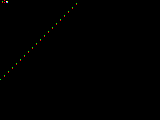 |
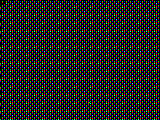 |
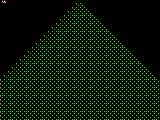 |
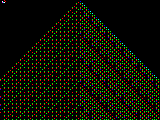 |
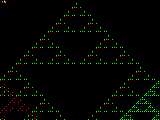 |
 |
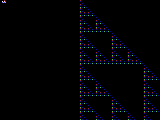 |
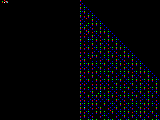 |
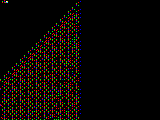 |
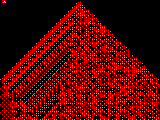 |
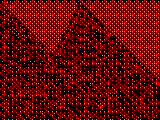 |
CA basically exhibits a few types of behavior. It can have the following behavior and the programs draw graphical representations of it. It can dead end and do nothing. Some cases don't go anywhere, nothing happens past the initial seed pixel which is intentional put on the screen. It can draw a straight or angled one dimensional line off of the initial seed pixel. It can fill the screen either with one solid color or a pattern such as alternating lines. It can produce a filled area of additive growth, such as a filled triangle that extends off of the seed pixel. It can produce regular and nested fractal patterns, which usually contain triangular forms. Finally it can produce, most surprising, chaos, patterns that look quite random but seem to have islands of order within them. I am not going to go into the details of CA here for a deeper look go to Stephen Wolfram A New Kind of Science where the entire text is available on line. For more one chaos theory material on this site see the Recursive Logistic Equation Page.
The basic concept uses AND/OR type of logic and a 8 bit bitmap to decide what color a pixel will become in a particular row and column based on values in the row before it at the positions directly above, above and to the left and above and to the right. The decisions made are based on a rule number. For example rule 0 = 00000000 results in a non-operation, no matter what the previous row had for the state of the pixel directly above and left/ right, the new pixel will be blank. The rule 255 = 11111111 will turn on the new pixel no matter what the state of the pixel directly above and left/ right. In between there are a bunch of different rules that respond by say turning on the new pixel when the pixel above it is on but the ones above it to the left and right are not on for example. Which would be rule 64 (0100000). The BASIC code for the pixel operations is as follows.
230 if point(x-1,y) <> 15 and point(x,y) <> 15 and point(x+1,y) <> 15 then pset(x,y+1),a[7]
240 if point(x-1,y) <> 15 and point(x,y) <> 15 and point(x+1,y) = 15 then pset(x,y+1),a[6]
250 if point(x-1,y) <> 15 and point(x,y) = 15 and point(x+1,y) <> 15 then pset(x,y+1),a[5]
260 if point(x-1,y) <> 15 and point(x,y) = 15 and point(x+1,y) = 15 then pset(x,y+1),a[4]
270 if point(x-1,y) = 15 and point(x,y) <> 15 and point(x+1,y) <> 15 then pset(x,y+1),a[3]
280 if point(x-1,y) = 15 and point(x,y) <> 15 and point(x+1,y) = 15 then pset(x,y+1),a[2]
290 if point(x-1,y) = 15 and point(x,y) = 15 and point(x+1,y) <> 15 then pset(x,y+1),a[1]
300 if point(x-1,y) = 15 and point(x,y) = 15 and point(x+1,y) = 15 then pset(x,y+1),a[0]
The function point returns TRUE or FALSE based on whether or not the pixel in that location contains the value 15, which is white in CGA, 4 bit color. Black corresponds to 0. Based on the logic <> ( not equal) or = (equal) plus anding the previous left, right and center pixels the new pixel in the row below the old is set using the pset function. The pset sets the pixel to color value a[0...7], the array a is encoded with the rule. What this means is that for let's say rule zero a[0] to a[7] are set to zero for black. So no matter what happens a black pixel is generated. As you can image if the rule turns the pixel black no matter what the CA will die out. The inverse case of 255 sets all of a[0] to a[7] 15 white, which floods the screen with white. The truth table for the rule number versus the logic used to represent it is as follows.
Rule LCR
128 000
64 001
32 010
16 011
8 100
4 101
2 110
1 111
L represents Left, C center and R right for the pixels(cells) above the pixel that needs to be drawn. The logic is such that the values shown yield a true. For instance rule 128 would mean Left pixel white = FALSE and Center pixel white = FALSE and Right pixel white = FALSE means paint new pixel with. Obviously the rules can be compounded to yield all the values from 0 - 255. For example rule 30 means apply 16+8+4+2 = 30, so apply the ones listed (16,8,4,2) in the truth table together. Thirty would be 011 AND 100 AND 101 AND 110.
Later versions of the programs used coding schemes for color so that the pixels were not just black and white but a shade of color depending on which part of the logic was being applied. This was done by loading the array a with values in terms of CGA color in the color handler subroutine. Looking at the code itself is the best way to understand it.
'color handler
1000 if n = 7 then a[n] = 0 '!RGB = blk
1001 if n = 6 then a[n] = 1 'XXB = blue
1002 if n = 5 then a[n] = 2 'XGX
1003 if n = 4 then a[n] = 3 'XGB = torq
1004 if n = 3 then a[n] = 4 'RXX
1005 if n = 2 then a[n] = 5 'RXB = pur
1006 if n = 1 then a[n] = 14 'RGX = yel
1007 if n = 0 then a[n] = 8 ' RGB but not, use gray
1008 return
Where n is the number of the array position for the corresponding line of the rule in the truth table (think 128 = 2^7), n is the exponent in terms of powers of 2. The color runs from black to gray, gray chosen instead of white to yield a higher color contrast. !RGB means black, with RGB ( Red/Green/Blue) turned off. XXB means turn CGA blue on a value of 1. XGB means green and blue ON for torquise, a value of 3 and so on.
This is the core functionality of the programs. Other than the logic above the initialization section converted the rule entered by the user 0-255 to the binary pattern of the rule which loads the color into the array a. From this point there is a nested looping that runs from 0-640 for the X direction and 0 - 480 for the Y direction. The loops are such that the X incrementing loop is inside of the Y loop. The program effectively scans each horizontal line pixel by pixel and performs a return at the end to the next row in the Y direction. In order to start off somewhere an initial seed pixel or pixels is needed in the first row. In the code there is an initialization that writes one white pixel in the center of the first row. I have also tried to put multiple initial pixels and patterns of them, this makes for interesting graphics as the multiple CA diagrams crash, merge or bounce off of one another. One of the most interesting ones looks like the migration of a fatigue crack in a solid material. For more on this topic on this site see CAFL Control Algorithm
CAT Transceiver control program
The CAT control light comes on when the transceiver is under remote control.
The screen on the PC showing CAT commands being executed. In the first the commandcat modesel am is being executed. This sets the mode to AM. In the second the command cat vfomr vfoa followed by cat vfomr vfob is sent. This command swaps between the two variable frequency oscillators in the transceiver. The frequency switches to 10MHz and then back to 7MHz.
The command structure for controlling the transceiver is fairly simple. The following is an example of the transaction across the serial bus for the command that would be entered as cat fset 1425000.
Protocol: 4800-1-8-2-N
Ex: FSET 1425000 (14.25000)
|01|42|50|00|FSET ... becomes... CMD Block = 0x00|0x50|0x42|0x01|0x08
LSD MSD
Transaction:
SI ------|0x00|0x50|0x42|0x01|0x08|--------------------------|0x??|xx|xx|xx|xx|------------------
command ACK
SO --------------------------------|0x00|0x50|0x42|0x01|0x08|------------------|SB|0x01|42|50|00|
echo 5-byte Status(5-86 is poss.)
(5ms gaps between SO and SI's.)
The following image is a screenshot of cat fset 009690, setting the frequency to 9.69MHz.
Yaesu provides all of the information in the manual that allows you to build code to control the transceiver. As you can see in the example above. First a command is sent, the transceiver then echoes this back, acknowledge is sent back to the transceiver, then transceiver then processes the command, then the transceiver sends back a variable length status. In the status SB is the leading status byte which is interpreted as follows.
Status Byte(SB)
BIT
7 CAT 1 = ON
6 CLAR 1 = ON
5 MR 1 = ON
4 VFO A/B 1 = VFO B
3 SPLIT 1 = ON
2 Tx Inhib 1 = ON
1 H/G 1 = G
0 PTT 1 = TX
The following is the list of commands that are possible, I kept with the syntax used by Yaesu. In other words CATSW in there list is sent out as cat catsw on by the program.
COMMANDS
(Hex)MSD (BCD) LSD
Instr CMD D1 D2 D3 D4 Remarks Status Size
-------------------------------------------------------------------------------------------------
CATSW 00 P1 XX XX XX p1 value: OO=ON. 01=OFF 86
CHECK 01 xx xx xx xx No op: return status Only 86
UP10Hz 02 xx xx xx xx Step frequency UP 10 Hz 5
DN10Hz 03 xx xx xx xx Step frequencv down 10 Hz 5
PRGUP 04 p1 p2 xx xx p1 & p2 * 5
PRGDN 05 p1 p2 xx xx p1 & p2 * 5
BANDUP 06 xx xx xx xx Step UP one Band** 5
BANDDN 07 xx xx xx xx Step down one Band** 5
FSET 08 p1 p2 p3 p4 Frequency Set (see EXAMPLE) 5
VFOMR 09 p1 xx xx xx VFO/Memory Select: p1 value: 00=VFO A,01 =VFO B, 02=MR 5
MEMSEL 0A p1 xx xx xx p1 value = memorv no.(0 -9) 8
MODESEL 0A p1 xx xx xx p1 value: 10h=LSB, 11h=USB,12h=CW.13h=AM 14h=FM,15h=FSK 8
HGSEL 0A p1 xx xx xx p1 value: 20h=HAM 21h=GEN 26
SPLITOG 0A 30h xx xx xx Toggles SPLIT on/off 26
CLARTOG 0A 40h xx xx xx Toggles Clarifier on/off 26
MTOV 0A 50h xx xx xx Memory to VFO 26
VTOM 0A 60h xx xx xx VFO to Memory 86
SWAP 0A 70h xx xx xx Swap VFO and Memory 5
ACLR 0A 80h xx xx xx Turn off SPLIT. CLAR. OFFSET 5
TONESET 0C p1 p2 p3 xx p1,p2 = Tone Freq(BCD) *** p3=00 for Low-Q 01 for Hi-Q 5
ACK 0b xx xx xx xx Required after each Code no echo
-------------------------------------------------------------------------------------------------
xx = any value: byte will be echoed, but will not affect command function.
* 00 00 to 99 99 representing 0 to 99.99 kHz (BCD)
.
** Band'steps determined by current Ham/Gen selection: Ham bands, or 0.5
MHz.
*** 06 70 to 25 03 representing 67.0 to 250.3 Hz (BCD). See Tone
Table 3 for list of valid tone frequencies.
Figure 2, the typos in this are not mine. The OCR from the bed scanner had trouble with reading this out of the FT767 manual.
Byte Contents Rer.
No. Table
1 Status Flaas . 1
2-5 Oneratina Freauencv (BCD) 2
6 Selected CTCSS Tone 3
7 Selected Mode 4
8 Selected Memorv Channel No. (0- 9)
9-12 Clarifier Freauencv (BCD) 2
13 Clarifier CTCSS Tone* 3
14 Clarifier Mode 4
15-18 VFO A FreQuencv (BCD) 2
19 VFO A CTCSS Tone* 3
20 VFO A Mode 4
21-24 VFO B Freauencv (BCD).. 2
25 VFO B CTCSS Tone* 3
26 VFO B Mode 4
27-30 Memorv Channel 0 Freahencv (BCD) 2
31 Memorv Channel 0 CTCSS Tone* 3
32 Memorv Channel 0 Mode 4
33-38 Memorv Ch 1 (same format as 27-32)**
39-44 Memorv Ch 2 (same format as 27-32)**
45-50 Memorv Ch 3 (same format as 27-32)**
51-56 Memorv Ch 4 (same format as 27-32)**
57-62 Memorv Ch 5 (same format as 27-32)**
63-6s.. Memorv Ch 6 (same format as 27-32)**
69-74 Memorv Ch 7 (same format as 27-32)**
75-80 Memorv Ch 8 (same format as 27-32)**
R1-RF; Mpmnru ('10 Q
The following screenshot is a status dump that occurs when cat catsw on is sent.
Debug mode- The CAT control program provides a debug mode for both the CAT.exe control program and the cattest.exe simulator program. When
either program is called with the /d argument, debugging output is provided. This is mostly for the development of the program, in the case of
the CAT program itself it can be used to troubleshoot the serial connection to and from the transceiver.
The following are a few screenshots of the CAT control program ran
with debug output The first is setting the frequency in debug mode, the
second is setting the modulation type to USB( upper side band) and the
third is a tweak the frequency up 10 Hz command.
By setting the frequency to 012345 which translates into 12.34500 MHz it is obvious from the debug data what is going on. The command for FSET is 8, the 10's and 100's Hertz are set to 0. So the command out is 0|45|23|1|8, CAT always sends things out 'backwards' and each byte sent out is a type of BCD-HEX format that goes as high as 99. The transceiver echoes back 0|45|23|1|8 to the CAT program. The CAT program reechoes the frequency and 0xb which is the ack upon which the transceiver changes the frequency to 12.34500. Then the transceiver sends out a 5 byte status to the CAT program. The status of 0|45|23|1|80. The status contains the frequency and 0x80 which is a bit map of flags, in this case with bit 7 set. Looking at the table below the status tells that CAT is ON, in control of the radio, VFO is A H/G(HAM/GENERAL COVERAGE) is set to H (HAM) and PTT
Status Byte(SB)
BIT
7 CAT 1 = ON
6 CLAR 1 = ON
5 MR 1 = ON
4 VFO A/B 1 = VFO B
3 SPLIT 1 = ON
2 Tx Inhib 1 = ON
1 H/G 1 = G
0 PTT 1 = TX
Software Portfolio
I am keeping a list of software that I have written for reference and for anyone that is interesting in more detail.
Software PortfolioOriginal Build Date:12-2-2000
Last updated 3-15-2010

